Astronomers have been waiting to see a very special kind of sunspot, and this week, they saw what they were hoping for: it was backward. It only lasted a few hours, but it reveals that the Sun’s next solar cycle could be getting underway. As the Sun moves through its 11-year cycle of solar maximum and minimums, the magnetic orientation of its sunspots reverses. Solar astronomers think that the upcoming Cycle 24 should be one of the stormiest in decades, producing many sunspots and powerful solar storms. The auroras should be beautiful.
Continue reading “A Magnetically Backwards Sunspot”
Sun’s Corona Simulated
A new simulation by NASA and the National Science Foundation accurately predicted what the Sun’s corona should look like during a recent solar eclipse. The corona is a turbulent region around the Sun which is shaped by twisting magnetic fields. Billions of tonnes of plasma are ejected into space as these fields suddenly snap to new configurations. The simulation too 4 days to complete on a supercomputer with 700 processors.
Continue reading “Sun’s Corona Simulated”
SOHO Mission Extended Through 2009
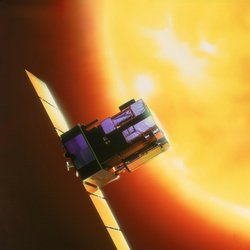
Artist illustration of SOHO and the Sun. Image credit: ESA. Click to enlarge
NASA and ESA’s long-running Solar and Heliospheric Observatory (SOHO) has been given another mission extension, this time until December 2009. The spacecraft was launched on December 2, 1995, and it has been steadily observing the Sun ever since. Over the next two years, five additional spacecraft will join SOHO to observe the Sun. ESA is involved in two of these spacecraft: Solar B, and Proba-2. NASA will launch the STEREO pair of spacecraft, as well as the Solar Dynamics Orbiter in 2008.
New funding, to extend the mission of ESA’s venerable solar watchdog SOHO, will ensure it plays a leading part in the fleet of solar spacecraft scheduled to be launched over the next few years.
Since its launch on 2 December 1995, The Solar and Heliospheric Observatory (SOHO) has provided an unprecedented view of the Sun – and not just the side facing the Earth. Two teams have now developed techniques for using SOHO to recreate the conditions on the far side of the Sun. The new funding will allow its mission to be extended from April 2007 to December 2009.
Despite being over ten years old now, SOHO just keeps on working, monitoring the activity on the Sun and allowing scientists to see inside the Sun by recording the seismic waves that ripple across the surface of our nearest star.
More than 2300 scientists have used data from the solar observatory to forward their research, publishing over 2400 scientific papers in peer-reviewed journals. During the last two years, at least one SOHO paper has been accepted for publication every working day.
“This mission extension will allow SOHO to cement its position as the most important spacecraft in the history of solar physics,” says Bernhard Fleck, SOHO’s project scientist, “There is a lot of valuable work for this spacecraft still to do.”
During the next two years, five new solar spacecraft will join SOHO in orbit. ESA is involved in two of these spacecraft. The Japan Aerospace Exploration Agency (ISAS/JAXA) has built Solar B and will launch it later this year. ESA will supply the use of a ground station at Svalbard, Norway in exchange for access to the data.
Next year, ESA will launch Proba-2, a technology demonstration satellite that carries solar instruments. In particular, it will carry a complementary instrument to SOHO’s EIT camera. Whilst EIT concentrates on the origin and early development of solar eruptions, Proba-2’s camera will be able to track them into space.
NASA plans to launch the STEREO pair of spacecraft later this year, and the Solar Dynamics Orbiter in 2008. Far from making SOHO obsolete, these newer solar satellites embrace it as a crucial member of the team. SOHO will provide a critical third point of view to assist the analysis of STEREO’s observations. Also, SOHO’s coronagraph will remain unique. The instrument is capable of blotting out the glare from the Sun so that the tenuous outer atmosphere of the Sun is visible for study.
“By next year, we will have a fleet of spacecraft studying the Sun,” says Hermann Opgenoorth, Head of Solar System Missions Division at ESA. This will advance the International Living With a Star programme (ILWS), an international collaboration of scientists dedicated to a long-term study of the Sun and its effects on Earth and the other solar system planets.
ILWS will possibly culminate in the launch of the advanced ESA satellite, Solar Orbiter, around 2015. It is designed to travel close to the Sun, to gain a close-up look at the powerful processes at the heart of our Solar System.
Original Source: ESA News Release
Solar Forecasting Decades Out
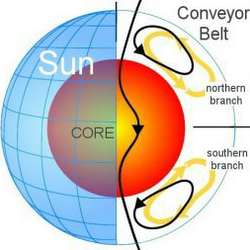
Solar astronomers are predicting a very low solar cycle 15 years from now, based on recent observations of the Sun. In the last few years, the Sun’s Great Conveyor Belt – which transfers hot plasma around the star – has slowed to half its normal speed. According to simulations, the speed of this conveyor translates into sunspot activity 20 years in the future. Solar Cycle 25, which peaks in the year 2022, should be one of the weakest ever observed.
The Sun’s Great Conveyor Belt has slowed to a record-low crawl, according to research by NASA solar physicist David Hathaway. “It’s off the bottom of the charts,” he says. “This has important repercussions for future solar activity.”
The Great Conveyor Belt is a massive circulating current of fire (hot plasma) within the Sun. It has two branches, north and south, each taking about 40 years to perform one complete circuit. Researchers believe the turning of the belt controls the sunspot cycle, and that’s why the slowdown is important.
“Normally, the conveyor belt moves about 1 meter per second??bf?walking pace,” says Hathaway. “That’s how it has been since the late 19th century.” In recent years, however, the belt has decelerated to 0.75 m/s in the north and 0.35 m/s in the south. “We’ve never seen speeds so low.”
According to theory and observation, the speed of the belt foretells the intensity of sunspot activity ~20 years in the future. A slow belt means lower solar activity; a fast belt means stronger activity. The reasons for this are explained in the Science@NASA story Solar Storm Warning.
“The slowdown we see now means that Solar Cycle 25, peaking around the year 2022, could be one of the weakest in centuries,” says Hathaway.
This is interesting news for astronauts. Solar Cycle 25 is when the Vision for Space Exploration should be in full flower, with men and women back on the Moon preparing to go to Mars. A weak solar cycle means they won’t have to worry so much about solar flares and radiation storms.
On the other hand, they will have to worry more about cosmic rays. Cosmic rays are high-energy particles from deep space; they penetrate metal, plastic, flesh and bone. Astronauts exposed to cosmic rays develop an increased risk of cancer, cataracts and other maladies. Ironically, solar explosions, which produce their own deadly radiation, sweep away the even deadlier cosmic rays. As flares subside, cosmic rays intensify-yin, yang.
Hathaway’s prediction should not be confused with another recent forecast: A team led by physicist Mausumi Dikpata of NCAR has predicted that Cycle 24, peaking in 2011 or 2012, will be intense. Hathaway agrees: “Cycle 24 will be strong. Cycle 25 will be weak. Both of these predictions are based on the observed behavior of the conveyor belt.”
How do you observe a belt that plunges 200,000 km below the surface of the sun?
“We do it using sunspots,” Hathaway explains. Sunspots are magnetic knots that bubble up from the base of the conveyor belt, eventually popping through the surface of the sun. Astronomers have long known that sunspots have a tendency to drift??bf?from mid solar latitudes toward the sun’s equator. According to current thinking, this drift is caused by the motion of the conveyor belt. “By measuring the drift of sunspot groups,” says Hathaway, “we indirectly measure the speed of the belt.”
Using historical sunspot records, Hathaway has succeeded in clocking the conveyor belt as far back as 1890. The numbers are compelling: For more than a century, “the speed of the belt has been a good predictor of future solar activity.”
If the trend holds, Solar Cycle 25 in 2022 could be, like the belt itself, “off the bottom of the charts.”
Original Source: NASA News Release
Next Solar Max Will Be a Big One
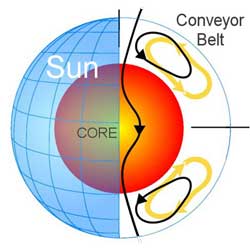
Illustration of the “conveyor belt” on the Sun. Image credit: NASA. Click to enlarge.
We’ve now reached the Sun’s solar minimum; there’s not a sunspot anywhere across the surface of our closest star. Give it a few years, though, and it should be anything but quiet. Solar researchers think they understand the long term cycles of solar activity, and they’re predicting that the next Solar Maximum – expected to arrive between 2010 and 2012 – will be the strongest in 50 years.
It’s official: Solar minimum has arrived. Sunspots have all but vanished. Solar flares are nonexistent. The sun is utterly quiet.
Like the quiet before a storm.
This week researchers announced that a storm is coming–the most intense solar maximum in fifty years. The prediction comes from a team led by Mausumi Dikpati of the National Center for Atmospheric Research (NCAR). “The next sunspot cycle will be 30% to 50% stronger than the previous one,” she says. If correct, the years ahead could produce a burst of solar activity second only to the historic Solar Max of 1958.
That was a solar maximum. The Space Age was just beginning: Sputnik was launched in Oct. 1957 and Explorer 1 (the first US satellite) in Jan. 1958. In 1958 you couldn’t tell that a solar storm was underway by looking at the bars on your cell phone; cell phones didn’t exist. Even so, people knew something big was happening when Northern Lights were sighted three times in Mexico. A similar maximum now would be noticed by its effect on cell phones, GPS, weather satellites and many other modern technologies.
Dikpati’s prediction is unprecedented. In nearly-two centuries since the 11-year sunspot cycle was discovered, scientists have struggled to predict the size of future maxima—and failed. Solar maxima can be intense, as in 1958, or barely detectable, as in 1805, obeying no obvious pattern.
The key to the mystery, Dikpati realized years ago, is a conveyor belt on the sun.
We have something similar here on Earth—the Great Ocean Conveyor Belt, popularized in the sci-fi movie The Day After Tomorrow. It is a network of currents that carry water and heat from ocean to ocean–see the diagram below. In the movie, the Conveyor Belt stopped and threw the world’s weather into chaos.
The sun’s conveyor belt is a current, not of water, but of electrically-conducting gas. It flows in a loop from the sun’s equator to the poles and back again. Just as the Great Ocean Conveyor Belt controls weather on Earth, this solar conveyor belt controls weather on the sun. Specifically, it controls the sunspot cycle.
Solar physicist David Hathaway of the National Space Science & Technology Center (NSSTC) explains: “First, remember what sunspots are–tangled knots of magnetism generated by the sun’s inner dynamo. A typical sunspot exists for just a few weeks. Then it decays, leaving behind a ‘corpse’ of weak magnetic fields.”
Enter the conveyor belt.
“The top of the conveyor belt skims the surface of the sun, sweeping up the magnetic fields of old, dead sunspots. The ‘corpses’ are dragged down at the poles to a depth of 200,000 km where the sun’s magnetic dynamo can amplify them. Once the corpses (magnetic knots) are reincarnated (amplified), they become buoyant and float back to the surface.” Presto—new sunspots!
All this happens with massive slowness. “It takes about 40 years for the belt to complete one loop,” says Hathaway. The speed varies “anywhere from a 50-year pace (slow) to a 30-year pace (fast).”
When the belt is turning “fast,” it means that lots of magnetic fields are being swept up, and that a future sunspot cycle is going to be intense. This is a basis for forecasting: “The belt was turning fast in 1986-1996,” says Hathaway. “Old magnetic fields swept up then should re-appear as big sunspots in 2010-2011.”
Like most experts in the field, Hathaway has confidence in the conveyor belt model and agrees with Dikpati that the next solar maximum should be a doozy. But he disagrees with one point. Dikpati’s forecast puts Solar Max at 2012. Hathaway believes it will arrive sooner, in 2010 or 2011.
“History shows that big sunspot cycles ‘ramp up’ faster than small ones,” he says. “I expect to see the first sunspots of the next cycle appear in late 2006 or 2007—and Solar Max to be underway by 2010 or 2011.”
Who’s right? Time will tell. Either way, a storm is coming.
Original Source: Science@NASA
SOHO Can See Right Through the Sun
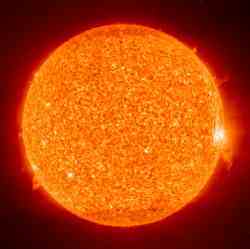
The Sun. Image credit: NASA/ESA Click to enlarge
NASA researchers have developed a technique that allows them to look right through the Sun to see what’s happening on the other side. The Solar and Heliospheric Observatory (SOHO) can trace the sound waves caused by active regions on the opposite side of the Sun. This technique allows the researchers to be more prepared when large sunspots rotate around to face the Earth, and better predict active space weather.
NASA researchers using the Solar and Heliospheric Observatory (SOHO) spacecraft have developed a method of seeing through the sun to the star’s far side. The sun’s far side faces away from the Earth, so it is not directly observable by traditional techniques.
“This new method allows more reliable advance warning of magnetic storms brewing on the far side that could rotate with the sun and threaten the Earth,” said NASA-supported scientist Phil Scherrer of Stanford University, Stanford, Calif.
Magnetic storms resulting from violent solar activity disrupt satellites, radio communications, power grids and other technological systems on Earth. Advance warning can help planners prepare for operational disruptions. The sun rotates once every 27 days, as seen from Earth, and this means the evolution of active regions on the far side of the sun previously has not been detectable.
Many of these storms originate in groups of sunspots, or active regions – areas with high concentration of magnetic fields. Active regions situated on the near side of the sun, the one facing the Earth, can be observed directly. However, traditional methods provided no information about active regions developing on the other side of the sun. Knowing whether there are large active regions on the opposite side of the sun may greatly improve forecast of potential magnetic storms.
The new observation method uses SOHO’s Michelson Doppler Imager (MDI) instrument to trace sound waves reverberating through the sun to build a picture of the far side.
The sun is filled with many kinds of sound waves caused by the convective (boiling) motion of gas in its surface layers. The far side imaging method compares the sound waves that emanate from each small region on the far side with what was expected to arrive at that small region from waves that originated on the front side. An active region reveals itself because its strong magnetic fields speed up the sound waves. The difference becomes evident when sound waves originating from the front side and from the back side get out of step with one another.
“The original far-side imaging method only allowed us to see the central regions, about one-quarter to one-third of its total area,” Scherrer said. “The new method allows us to see the entire far side, including the poles.” Scherrer started an effort to use the new method to create full far-side images from archived MDI data collected since 1996. The project was completed in December 2005.
Douglas Biesecker of the National Oceanic and Atmospheric Administration’s Space Environment Center, Boulder, Colo., said, “With the new far side photo album going back to 1996, we can discover identifying characteristics of active regions. This will improve our ability to distinguish real active regions.”
SOHO is a cooperative project between the European Space Agency and NASA. For SOHO information and images on the Web, visit:
www.nasa.gov/vision/universe/solarsystem/soho_xray.html
Original Source: NASA News Release
Solar Minimum Doesn’t Mean a Calm Sun
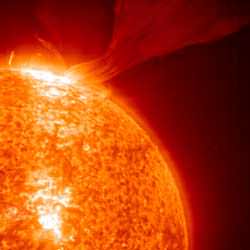
A huge solar explosion in 2001. Image credit: SOHO. Click to enlarge.
There’s a myth about the sun. Teachers teach it. Astronomers repeat it. NASA mission planners are mindful of it.
Every 11 years solar activity surges. Sunspots pepper the sun; they explode; massive clouds of gas known as “CMEs” hurtle through the solar system. Earth gets hit with X-rays and protons and knots of magnetism. This is called solar maximum.
There’s nothing mythical about “Solar Max.” During the most recent episode in 2000 and 2001, sky watchers saw auroras as far south as Mexico and Florida; astronomers marveled at the huge sunspots; satellite operators and power companies struggled with outages.
Now the sun is approaching the opposite extreme of its activity cycle, solar minimum, due in 2006. We can relax because, around solar minimum, the sun is quiet. Right?
“That’s the myth,” says solar physicist David Hathaway of the NASA Marshall Space Flight Center. The truth is, solar activity never stops, “not even during solar minimum.”
To show that this is so, Hathaway counted the number of X-class solar flares each month during the last three solar cycles, a period spanning 1970 to the present. X-flares are the most powerful kind of solar explosions; they’re associated with bright auroras and intense radiation storms. “There was at least one X-flare during each of the last three solar minima,” says Hathaway.
This means astronauts traveling through the solar system, far from the protection of Earth’s atmosphere and magnetic field, can’t drop their guard–ever.
Recent events bear this out: Rewind to January 10, 2005. It’s four years since solar maximum and the sun is almost blank–only two tiny sunspots are visible from Earth. The sun is quiet.
The next day, with stunning rapidity, everything changes. On January 11th, a new ‘spot appears. At first no more than a speck, it quickly blossoms into a giant almost as big as the planet Jupiter. “It happened so quickly,” recalls Hathaway. “People were asking me if they should be alarmed.”
Between January 15th and 20th, the sunspot unleashed two X-class solar flares, sparked auroras as far south as Arizona in the United States, and peppered the Moon with high-energy protons. Lunar astronauts caught outdoors, had there been any, would’ve likely gotten sick.
So much for the quiet sun.
It almost happened again last month. On April 25, 2005, small sunspot emerged and–d?j? vu–it grew many times wider than Earth in only 48 hours. This time, however, there were no eruptions.
Why not? No one knows.
Sunspots are devilishly unpredictable. They’re made of magnetic fields poking up through the surface of the sun. Electrical currents deep inside our star drag these fields around, causing them to twist and tangle until they become unstable and explode. Solar flares and CMEs are by-products of the blast. The process is hard to forecast because the underlying currents are hidden from view. Sometimes sunspots explode, sometimes they don’t. Weather forecasting on Earth was about this good … 50 years ago.
Researchers like Hathaway study sunspots and their magnetic fields, hoping to improve the woeful situation. “We’re making progress,” he says.
Good thing. Predicting solar activity is more important than ever. Not only do we depend increasingly on sun-sensitive technologies like cell phones and GPS, but also NASA plans to send people back to the Moon and then on to Mars. Astronauts will be “out there” during solar maximum, solar minimum and all times in between.
Will the sun be quiet when it’s supposed to be? Don’t count on it.
Original Source: Science@NASA Article
More Sunlight is Hitting the Earth
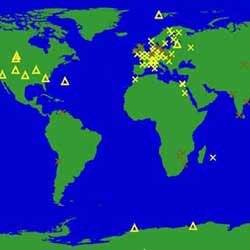
Global map of brightness increases. Yellow represents an increase, brown is decreasing. Image credit: PNL. Click to enlarge.
Earth’s surface has been getting brighter for more than a decade, a reversal from a dimming trend that may accelerate warming at the surface and unmask the full effect of greenhouse warming, according to an exhaustive new study of the solar energy that reaches land.
Ever since a report in the late 1980s uncovered a 4 to 6 percent decline of sunlight reaching the planet’s surface over 30 years since 1960, atmospheric scientists have been trying out theories about why this would be and how it would relate to the greenhouse effect, the warming caused by the buildup of carbon dioxide and other gasses that trap heat in the atmosphere.
Meanwhile, a group led by Martin Wild at the Swiss Federal Institute of Technology in Zurich, home of the international Baseline Surface Radiation Network (BSRN) archive, had gone to work collecting surface measurements and crunching numbers.
“BSRN didn’t get started until the early ’90s and worked hard to update the earlier archive,” said Charles N. Long, senior scientist at the Department of Energy’s Pacific Northwest National Laboratory and co-author of a BSRN report in this week’s issue (Friday, May 6) of the journal Science.
“When we looked at the more recent data, lo and behold, the trend went the other way,” said Long, who conducted the work under the auspices of DOE’s Atmospheric Radiation Measurement (ARM) program.
Data analysis capabilities developed by ARM research were crucial in the study, which reveals the planet’s surface has brightened by about 4 percent the past decade. The brightening trend is corroborated by other data, including satellite analyses that are the subject of another paper in this week’s Science.
Sunlight that isn’t absorbed or reflected by clouds as it plunges earthward will heat the surface. Because the atmosphere includes greenhouse gasses, solar warming and greenhouse warming are related.
“The atmosphere is heated from the bottom up, and more solar energy at the surface means we might finally see the increases in temperature that we expected to see with global greenhouse warming,” Long said.
In fact, he said, many believe that we have already been seeing those effects in our most temperature-sensitive climates, with the melting of polar ice and high altitude glaciers.
The report’s authors stopped short of attributing a cause to the cycle of surface dimming and brightening, but listed such suspects as changes in the number and composition of aerosols?liquid and solid particles suspended in air?and how aerosols affect the character of clouds. Over the past decade, the ARM program has built a network of instrumentation sites to sample cloud characteristics and energy transfer in a variety of climates, from tropical to polar.
“The continuous, sophisticated data from these sites will be crucial for determining the causes,” Long said.
Long also pointed out that 70 percent of the planet’s surface is ocean, for which we have no long-term surface brightening or dimming measurements.
PNNL (www.pnl.gov) is a DOE Office of Science laboratory that solves complex problems in energy, national security, the environment and life sciences by advancing the understanding of physics, chemistry, biology and computation. PNNL employs more than 4,000 staff, has a $650 million annual budget, and has been managed by Ohio-based Battelle since the lab’s inception in 1965.
Original Source: PNL News Release
SOHO Sees a Huge Prominence on the Sun
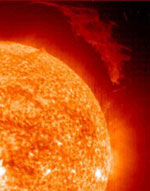
Image credit: SOHO
On Friday, 12 March 2004, the Sun ejected a spectacular ‘eruptive prominence’ into the heliosphere. SOHO, the ESA/NASA solar watchdog observatory, faithfully recorded the event.
This ‘eruptive prominence’ is a mass of relatively cool plasma, or ionised gas. We say ‘relatively’ cool, because the plasma observed by the Extreme-ultraviolet Imaging Telescope (EIT) on board SOHO was only about 80 000 degrees Celsius, compared to the plasma at one or two million degrees Celsius surrounding it in the Sun’s tenuous outer atmosphere, or ‘corona’.
At the time of this snapshot, the eruptive prominence seen at top right was over 700 000 kilometres across – over fifty times Earth’s diameter – and was moving at a speed of over 75 000 kilometres per hour.
Eruptive prominences of this size are associated with coronal mass ejections (CMEs), and the combination of CMEs and prominences can affect Earth’s magnetosphere when directed toward our planet. In this case, the eruptive prominence and associated CME were directed away from Earth.
SOHO is a mission of international co-operation between ESA and NASA, launched in December 1995. Every day SOHO sends thrilling images from which research scientists learn about the Sun’s nature and behaviour. Experts around the world use SOHO images and data to help them predict ‘space weather’ events affecting our planet.
Original Source: ESA News Release
